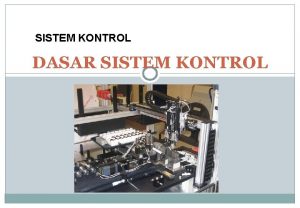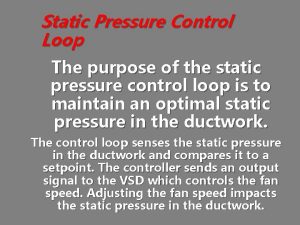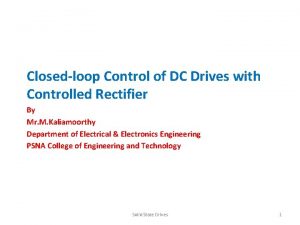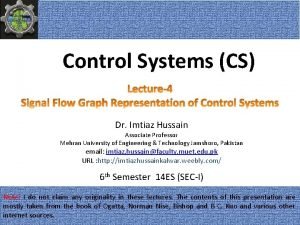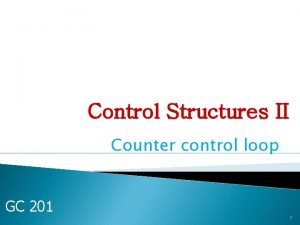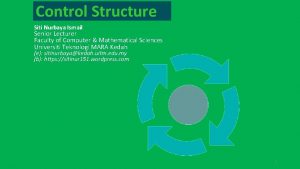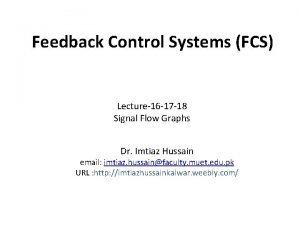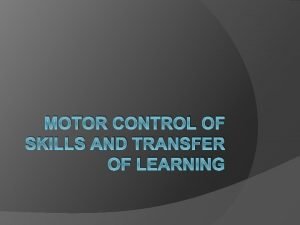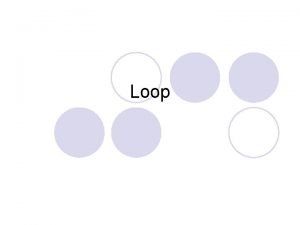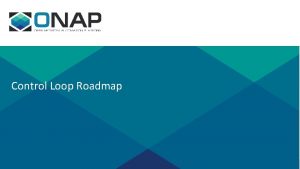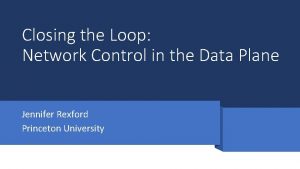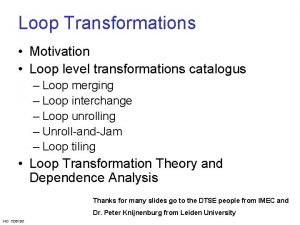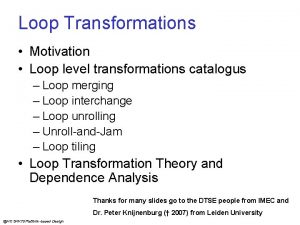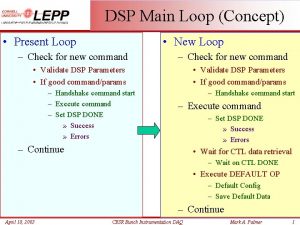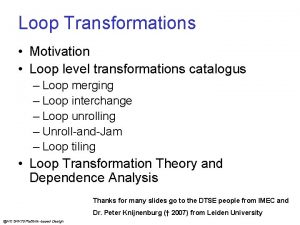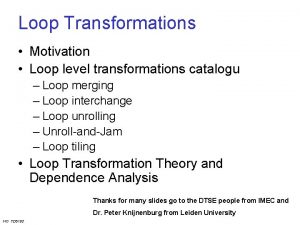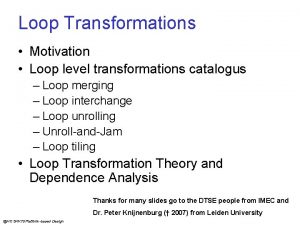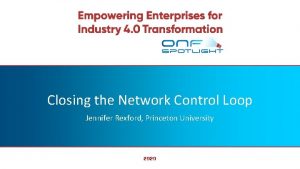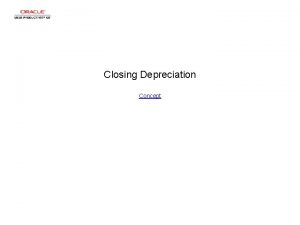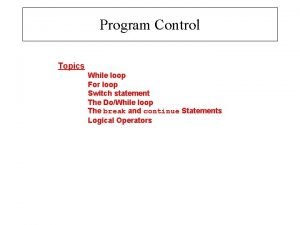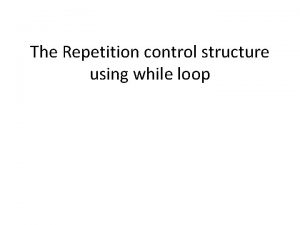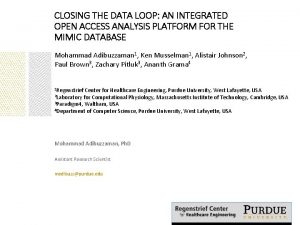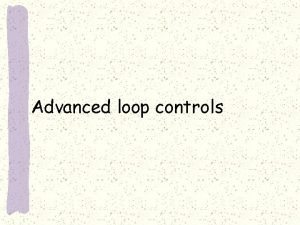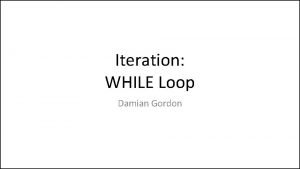Closing the Loop Network Control in the Data











![Con. Quest: Avoiding Per-Flow State • Compact data structures Count-Min Sketch [CM ‘ 05] Con. Quest: Avoiding Per-Flow State • Compact data structures Count-Min Sketch [CM ‘ 05]](https://slidetodoc.com/presentation_image_h/304efa54b124fa89a8d1bec3e2aed7cd/image-12.jpg)



![Performance-Aware Routing: Contra [NSDI’ 20] G 1: Traffic Engineering e. g. , prefer least Performance-Aware Routing: Contra [NSDI’ 20] G 1: Traffic Engineering e. g. , prefer least](https://slidetodoc.com/presentation_image_h/304efa54b124fa89a8d1bec3e2aed7cd/image-16.jpg)







- Slides: 23

Closing the Loop: Network Control in the Data Plane Jennifer Rexford Princeton University

Traditional Network Management 2. Analyze (traffic matrix, route optimization, anomaly detection, fault localization) 1. Measure (load, performance, traffic, failures) 3. Configure (reconfigure tunnels, link weights, access control lists)

Limitations of Traditional Network Management • Measurement mismatches • Overhead of collecting many device-local measurements • Simplistic statistics (counts, samples) not tailored to the task • Indirect control • Configuration of complex protocols and mechanisms • Separate configuration of many distributed devices • Complex reasoning • Many separate software components and protocols • Software bugs, configuration errors, and protocol interactions

Closing the Loop • An integrated approach • Efficient measurement Network-wide goals (objectives and constraints) • Measurement tailored to the task • Data analysis in the data plane • Direct control Compiler Device-local programs (measure and control) • Control actions in the data plane • Correct by construction • Device-local programs synthesized from network-wide goals

Protocol Independent Switch Architecture (PISA) • Data plane designed for programmability • Parsing, match-action tables, actions, registers • Barefoot/Intel (Arista, Novi. Flow, Stordis), Xilinx, Netronome, Pensando, Netcope • P 4 programming language Registers ALU Memory Parser Deparser Match. Action Table Stages

Example Network-Wide Goals • Alleviating microbursts • Performance-aware routing • Denial-of-service attack mitigation • Block hosts with old OSes • <Insert your “app” here>

• Small timescale traffic bursts • Clog the packet queues • Cause packet delay and loss • Manage microbursts to handle Queue Length Alleviating Microbursts: Con. Quest [Co. Next’ 19] 5 x Microbursts 3 x 1 x 16: 00 0: 00 8: 00 Time in day (24 h) • Bursty workloads • Low-cost switches (shallow buffers) • High link utilization • Goal: penalize the most responsible flows 16: 00

Microburst Management Policy • Active queue management • Mark each packet probabilistically • In proportion to its flow’s contribution to the heavy queue 55% 10%

Detecting Heavy Flows in the Queue • For each flow, how many packets are in the queue? Key Count 1 5 1 • P 4 data structure challenges • Updating on packet arrival and departure • Per-flow state (key and count) 1 2 1 9

Con. Quest: Processing Each Packet Only Once • Slice traffic into time windows • Each snapshot records T=4 packets B A B C B B BQueue D B A CB D S 1 S 2 S 3 S 4 … Egress Why am I waiting? I enqueued at t=5 I dequeued at t=14 Memory access Flow ~Count A 1 ? B 5 C 1 D 1 Historical Departures 10

Con. Quest: Round-Robin Snapshots Read Clean Write Read • Clean and Reuse the snapshots in the data plane! 11
![Con Quest Avoiding PerFlow State Compact data structures CountMin Sketch CM 05 Con. Quest: Avoiding Per-Flow State • Compact data structures Count-Min Sketch [CM ‘ 05]](https://slidetodoc.com/presentation_image_h/304efa54b124fa89a8d1bec3e2aed7cd/image-12.jpg)
Con. Quest: Avoiding Per-Flow State • Compact data structures Count-Min Sketch [CM ‘ 05] • With limited memory and processing • … at the expense of lower accuracy • Estimate per-flow counts per snapshot • With accurate estimates for large flows • Count-Min Sketch per snapshot • C columns indexed by hash functions • Increment hashi(flowid) in column I • Estimate is the min of the C counts +1 +1 B Buckets +1 f C columns

Con. Quest in Action on the Princeton Campus Internet 2 • Performance symptoms • Big neuroscience data transfers • High loss with low average load • Router with limited measurements Network TAPs Mirrored traffic Neuroscience Institute Tofino • Microburst analytics on Tofino • Microbursts on a small timescale • Caused by Perf. SONAR active probes • Recent deployment with AT&T See https: //p 4 campus. cs. princeton. edu/ web site for more details! 13

Con. Quest: Closing the Control Loop • Testbed with P 4 -enabled Barefoot Tofino, 4 snapshots • Smart early congestion notification (ECN) • Baseline: mark all packets when the queue is long • Con. Quest: flow-based ECN to mark flows causing others to wait Send 1 M TCP flows + synthetic bursts 100 G Sender 10 G Receiver 14

Con. Quest: Evaluating the Control Loop üFlow-based ECN reduces Flow Completion Time üQueue remains short, bursty flow effectively suppressed 11% 15
![PerformanceAware Routing Contra NSDI 20 G 1 Traffic Engineering e g prefer least Performance-Aware Routing: Contra [NSDI’ 20] G 1: Traffic Engineering e. g. , prefer least](https://slidetodoc.com/presentation_image_h/304efa54b124fa89a8d1bec3e2aed7cd/image-16.jpg)
Performance-Aware Routing: Contra [NSDI’ 20] G 1: Traffic Engineering e. g. , prefer least utilized paths G 2: Routing Constraints e. g. , middlebox traversal G 3: Fast Adaptation e. g. , update path choices upon performance changes

Contra: Performance-Aware Routing Policy Topology Contra compiler Switch programs • Language + Compiler: Compiles rich, high-level policies • Runtime: Performance-aware routing protocol in the data plane

Contra Policy Language • Routing policy: a function that ranks network paths • Matching on paths using regular expressions • Computing and comparing path metrics Waypoint W with min utilization if (. * W. *) then path. util else ∞ Min utilization under light load, otherwise shortest if (path. util < 0. 8) then (1, 0, path. util) else (2, path. len, path. util) 18

Contra Family of P 4 Routing Programs • Distance vector routing • Flexible path constraints and metrics • Implementable in modern P 4 data planes path probe: 0. 3 0. 2 0. 3 data packets 19

Contra P 4 Building Blocks • Monitor path performance • Reverse-path probes collect and accumulate statistics • Enforce path constraints • Controlling the propagation of probes • Compare and select paths • Best-path table updated as new probes arrive • Avoid out-of-order packets • Policy-aware flowlet switching table • Prevent forwarding loops • Version numbers of probes (like DSDV and Babel)

Contra Prototype and Evaluation • Contra compiler • Written in 7485 lines of F# • Generates the switch-local P 4 programs • Experimental setup • Topologies: data centers, random graphs, ISPs • Performance metric: flow completion time (FCT) • Comparisons: equal-cost multipath, Hula, and SPAIN Routing Policy Compiler P 4 code • Simulation (in ns-3) and testbed (in Cloud. Lab) • Outperforms shortest-path routing and static load balancing 21

Toward Verified Closed-Loop Control • Explore more control-loop examples • DDo. S mitigation, blocking unwanted OSes, etc. • Evaluate under realistic conditions • Hardware switches and operational networks • Identify unifying language constructs • Traffic queries integrated with control actions • Verify the compiler • Ensure the P 4 programs are ``correct by construction” Pronto project (ONF, Stanford, Princeton, Cornell): https: //vimeo. com/447287550

Thank you!
 Manakah yang lebih baik open loop atau close loop system
Manakah yang lebih baik open loop atau close loop system Fifth gear loop the loop
Fifth gear loop the loop Open loop vs closed loop in cars
Open loop vs closed loop in cars Manakah yang lebih baik open loop atau close loop system
Manakah yang lebih baik open loop atau close loop system While do loop
While do loop Accidental whorl
Accidental whorl Multi loop pid controller regolatore pid multi loop
Multi loop pid controller regolatore pid multi loop Hdlc adalah
Hdlc adalah Pressure control loop
Pressure control loop Closed loop control of dc drives
Closed loop control of dc drives Non touching loop example
Non touching loop example Counter controlled while loop
Counter controlled while loop Control loop performance monitoring
Control loop performance monitoring Loop control structure
Loop control structure Non touching loop example
Non touching loop example Open loop control motor learning
Open loop control motor learning Loop control structure
Loop control structure Perangkat yang meletakkan data ke local loop disebut
Perangkat yang meletakkan data ke local loop disebut Datagram approach
Datagram approach What is topology in computer
What is topology in computer Features of peer to peer network and client server network
Features of peer to peer network and client server network Network systems design using network processors
Network systems design using network processors Network centric computing and network centric content
Network centric computing and network centric content Packet switching vs circuit switching
Packet switching vs circuit switching
